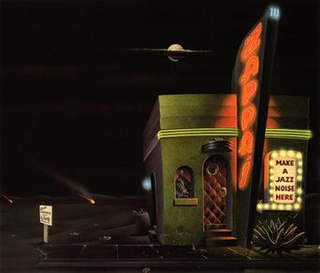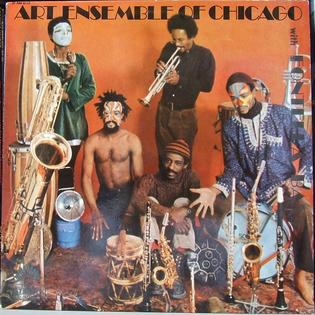
In music, an arrangement is a musical adaptation of an existing composition. Differences from the original composition may include reharmonization, melodic paraphrasing, orchestration, or formal development. Arranging differs from orchestration in that the latter process is limited to the assignment of notes to instruments for performance by an orchestra, concert band, or other musical ensemble. Arranging "involves adding compositional techniques, such as new thematic material for introductions, transitions, or modulations, and endings. Arranging is the art of giving an existing melody musical variety". In jazz, a memorized (unwritten) arrangement of a new or pre-existing composition is known as a head arrangement.

Ian Ernest Gilmore Evans was a Canadian–American jazz pianist, arranger, composer and bandleader. He is widely recognized as one of the greatest orchestrators in jazz, playing an important role in the development of cool jazz, modal jazz, free jazz, and jazz fusion. He is best known for his acclaimed collaborations with Miles Davis.

The Art Ensemble of Chicago is an avant-garde jazz group that grew out of the Association for the Advancement of Creative Musicians (AACM) in the late 1960s. The ensemble integrates many jazz styles and plays many instruments, including "little instruments": bells, bicycle horns, birthday party noisemakers, wind chimes, and various forms of percussion. The musicians would wear costumes and face paint while performing. These characteristics combined to make the ensemble's performances both aural and visual. While playing in Europe in 1969, five hundred instruments were used.

Lester Bowie was an American jazz trumpet player and composer. He was a member of the Association for the Advancement of Creative Musicians and co-founded the Art Ensemble of Chicago.
The swing era was the period (1933–1947) when big band swing music was the most popular music in the United States, especially for teenagers. Though this was its most popular period, the music had actually been around since the late 1920s and early 1930s, being played by black bands led by such artists as Duke Ellington, Jimmie Lunceford, Bennie Moten, Cab Calloway, Earl Hines, and Fletcher Henderson, and white bands from the 1920s led by the likes of Jean Goldkette, Russ Morgan and Isham Jones. An early milestone in the era was from "the King of Swing" Benny Goodman's performance at the Palomar Ballroom in Los Angeles on August 21, 1935, bringing the music to the rest of the country. The 1930s also became the era of other great soloists: the tenor saxophonists Coleman Hawkins, Ben Webster and Lester Young; the alto saxophonists Benny Carter and Johnny Hodges; the drummers Chick Webb, Gene Krupa, Jo Jones and Sid Catlett; the pianists Fats Waller and Teddy Wilson; the trumpeters Louis Armstrong, Roy Eldridge, Bunny Berigan, and Rex Stewart.

Make a Jazz Noise Here is a live double album by Frank Zappa. It was first released in June 1991, and was the third Zappa album to be compiled from recordings from his 1988 world tour, following Broadway the Hard Way (1988) and The Best Band You Never Heard in Your Life (1991). The album's cover art was made by Larry Grossman.

Joseph Bowie is an American jazz trombonist and vocalist. The brother of trumpeter Lester Bowie, Joseph is known for leading the jazz-punk group Defunkt and for membership in the Ethnic Heritage Ensemble.

"In My Bed" is a song by English singer-songwriter Amy Winehouse from her debut studio album Frank (2003). It was released on 5 April 2004 as the album's third single, reaching number 60 on the UK Singles Chart.

The 50th Annual Grammy Awards took place at the Staples Center in Los Angeles, on February 10, 2008. It honored musical achievement of 2007 in which albums were released between October 1, 2006, through September 30, 2007. The primary ceremonies were televised in the US on CBS; however, as has become the custom, most of the awards were handed out during a pre-telecast portion of the show held at the Los Angeles Convention Center and broadcast on XM Satellite Radio. Two nights prior to the show Aretha Franklin was honored as the MusiCares Person of the Year.

I Only Have Eyes for You is an album by Lester Bowie's Brass Fantasy recorded in February 1985 and released on ECM the following year—Bowie's third release for the label, and the Brass Fantasy's debut. The ensemble features Vincent Chancey, Craig Harris, Steve Turre, Malachi Thompson, Stanton Davis, Bob Stewart, Bruce Purse, and Phillip Wilson.

Live at the 6th Tokyo Music Joy is a live album by the Art Ensemble of Chicago and Lester Bowie's Brass Fantasy recorded in February 1990 for the Japanese DIW label. It is the only recording to showcase both of the groups that Lester Bowie established and features performances by the Art Ensemble, the Brass Fantasy and both bands.

Congliptious is a 1968 album by Roscoe Mitchell's Art Ensemble which later became the Art Ensemble of Chicago. It was released on the Nessa label and features performances by Mitchell, Lester Bowie, Malachi Favors, and Robert Crowder. "Tutankhamen" is a bass solo by Malahi Favors, "Tkhke" is an alto saxophone solo by Roscoe Mitchell and "Jazz Death?" is a trumpet solo by Lester Bowie with the full ensemble performing "Congliptious/Old".

Art Ensemble of Chicago with Fontella Bass is a 1970 album by the Art Ensemble of Chicago recorded in Paris and released on the America label in 1971 then reissued in the US on Prestige Records the following year. It features performances by Lester Bowie, Joseph Jarman, Roscoe Mitchell, Malachi Favors Maghostut, Fontella Bass, and Don Moye.

Go Home is a 1970 album by the Art Ensemble of Chicago recorded in Paris for the French Galloway label - first released in 1973. It features performances by Lester Bowie, Joseph Jarman, Roscoe Mitchell and Malachi Favors Maghostut along with Fontella Bass, Ivan Julien, Bernard Vitet, Ambrose Jackson, Jean Louis Chautemps, Alain Matot, Ventosa, Kenneth Terroade, Raymond Katarzinsky and several unidentified musicians.
Phillip Sanford Wilson was an American blues and jazz drummer, a founding member of the Art Ensemble of Chicago, and a member of the Paul Butterfield Blues Band.

Secrets of Flying is the second and final album released by Bahamian-American singer-songwriter Johnny Kemp. Released at the end of 1987, this album featured two massively successful singles. The album's first hit was the Grammy-nominated single "Just Got Paid", which cracked the top 10 on the Billboard Hot 100 in 1988 and went on to top both the R&B chart and Hot Dance Music/Club Play chart. The album's second hit, "Dancin' with Myself", also became a top 5 R&B success. A third single from the album, the slow jam "One Thing Led to Another", reached the R&B top 40 as well.

Kenton's West Side Story is an album by the Stan Kenton Orchestra recorded in 1961 and released by Capitol Records. It won the Grammy Award in 1962 for Best Jazz Performance – Large Group (Instrumental). The album was recorded in 1961 and released quickly to take advantage of the movie premiere of the musical West Side Story. Kenton won his first Grammy Award and he won again the next year in the same category with Adventures in Jazz. Kenton's West Side Story peaked at No. 16 on the Billboard magazine album chart.

Big Boss Band is the 1990 studio album of American musician George Benson on Warner Bros. featuring the Count Basie Orchestra. This is Benson's second consecutive album which returns to his jazz roots after his successful pop career in the 1980s, and also his debut as sole producer of an album. The genre is mainly big band swing with some Michel Legrand and R&B thrown in.
Vincent Henry is an American saxophonist and guitarist who plays jazz and R&B.
Young was a Canadian rock music group led by Danny Squire.They released a few singles and an album during the 1970s. They had success with "Goin' to the Country" which was a hit in both Canada and the United States. Their album also spent about 14 weeks in the charts. The group may have been working on a second album prior to their break up.
















